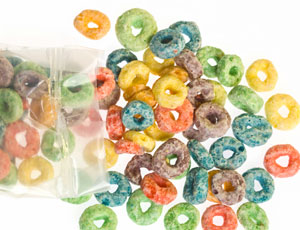Kellogg is recalling as many as 28 million boxes of cereal because a chemical is leaching from the food packaging into the cereal. The Food and Drug Administration states the reason for the recall as "uncharacteristic off-flavor and smell coming from the liner in the package." Other sources call it a wax-like substance, and parents are being warned that it may cause diarrhea or vomiting, particularly in sensitive children (the recalled cereals - Apple Jacks, Corn Pops, Froot Loops and Honey Smacks - are sugary staples of the Kellogg line, marketed with cartoon characters primarily at children).
The incident highlights a little-appreciated concern: While packaging can help food last longer, it can also leach chemicals into foods. The public is becoming increasingly aware of this since Bisphenol A has been making news. That chemical, found in many hard plastics, has been shown to leach into liquids from water bottles, baby bottles, the lining of cans and other common food packaging, particularly in older plastics that have stored hot foods or beverages. Concern has grown over food packaging, since public awareness has increased about the potential health effects of BPA, which can disrupt the endocrine system and mimic estrogen, and which may influence health issues ranging from prostate cancer to mental development.
Unlike the chemical affecting Kellogg's cereals, Bisphenol A and other food packaging chemicals are typically invisible, odorless and colorless, so you'd never know they were leaching into foods or drinks. And unlike more familiar toxic contaminants where "the dose make the poison," these chemicals may cause health effects at minute levels, primarily because they are so similar, chemically, to human hormones. Scientists are busy studying the effects of these so-called endocrine disruptors, and the list of potential health effects of exposure to hormone mimicking chemicals, alone or in combination, is long, ranging from weight gain to cancer, with the risk most acute early in life (even in the womb).
A 2009 study of 50 legal food packaging substances that are known endocrine disruptors by Jane Muncke, a researcher with Emhart Glass, a Swiss glass packaging company, concluded that "Food contact materials are a major source of food contaminants," that many toxic chemicals and suspected endocrine disruptors can leach from food packaging, and that many chemicals that can leach from food packaging remain unidentified and unstudied.
"There is sufficient evidence that endocrine disrupting compounds pose a risk to human and environmental health. Even at low concentrations, chronic exposure to endocrine disrupting compounds is of toxicological concern and this concern increases when humans are exposed to mixtures of similar acting endocrine disrupting compounds and/or during sensitive windows of development," Muncke writes. "The widespread use of chemicals with endocrine disrupting properties in food packaging thus might present a risk, and it requires dedicated assessment."
Some examples of documented food packaging leaching:
- Glass bottles - lead, a known neuro-toxin most risky for young children
- Metal closures of glass jars - certain phthalates that have been banned or had use restricted in certain children's toys in the U.S. and Europe
- Seafood packaged in metal cans - Bisphenol A
- Paper packaging - Perfluorinated compounds linked to immunity, reproductive and developmental problems
- Beer and soda cans - Ortho-phenylphenol, a pesticide used to kill bacteria and fungus that is also found on many other foods, and with unknown effects at low doses
- Milk, juice and wine cartons - benzophenone, which mimics estrogen
- Flour and rice wrappers - Tricolsan, a anti-bacterial pesticide also used in soaps that causes environmental problems after being washed down the drain
What can you do to avoid these chemicals? Buying in bulk is one method, and buying from companies that are as careful about their packaging as their foods is another. Several companies, particularly manufacturers of water and baby bottles, have stopped using Bisphenol A, and advertise it on their packages; many other chemicals remain in use, but you won't find any mention on the packages or ingredient labels.
Details About Kellogg's Cereal Recall
Only products with the letters "KN" following the Better If Used Before Date are included in the recall. Products with a "KM" designation are NOT included in the recall. In addition, no products in Canada are affected.
Kellogg's Apple Jacks
- UPC 3800039136 1: 17 ounce package with Better if Used Before Dates between APR 10 2011 and JUN 22 2011
- UPC 3800039132 3: 8.7 ounce packages with Better if Used Before Dates between JUN 03 2011 and JUN 22 2011
- UPC 3800039109 5: 12.5 ounce packages with Better if Used Before Dates between MAR 26 2011 and JUN 22 2011
- UPC 3800039111 8: 17.2 ounce packages with Better if Used Before Dates between MAR 26 2011 and JUN 22 2011
- UPC 3800039116 3: 9.2 ounce packages with Better if Used Before Dates between APR 05 2011 and JUN 22 2011
- UPC 3800039118 7: 12.2 ounce packages with Better if Used Before Dates between MAR 26 2011 and JUN 22 2011
- UPC 3800039120 0: 17 ounce packages with Better if Used Before Dates between MAR 26 2011 and JUN 22 2011
- UPC 3800039125 5: 8.7 ounce packages with Better if Used Before Dates between MAR 26 2011 and JUN 22 2011
- UPC 3800039103 3: 15.3 ounce packages with Better if Used Before Dates between MAR 26 2011 and JUN 22 2011




Comment: Concerned about chemicals leaching from food packaging and the possible health risks? Read the following articles:
Chemicals Leach From Packaging
Toxic Glue Used in Supermarket Food Packaging 'Poses Severe Risk to Health'